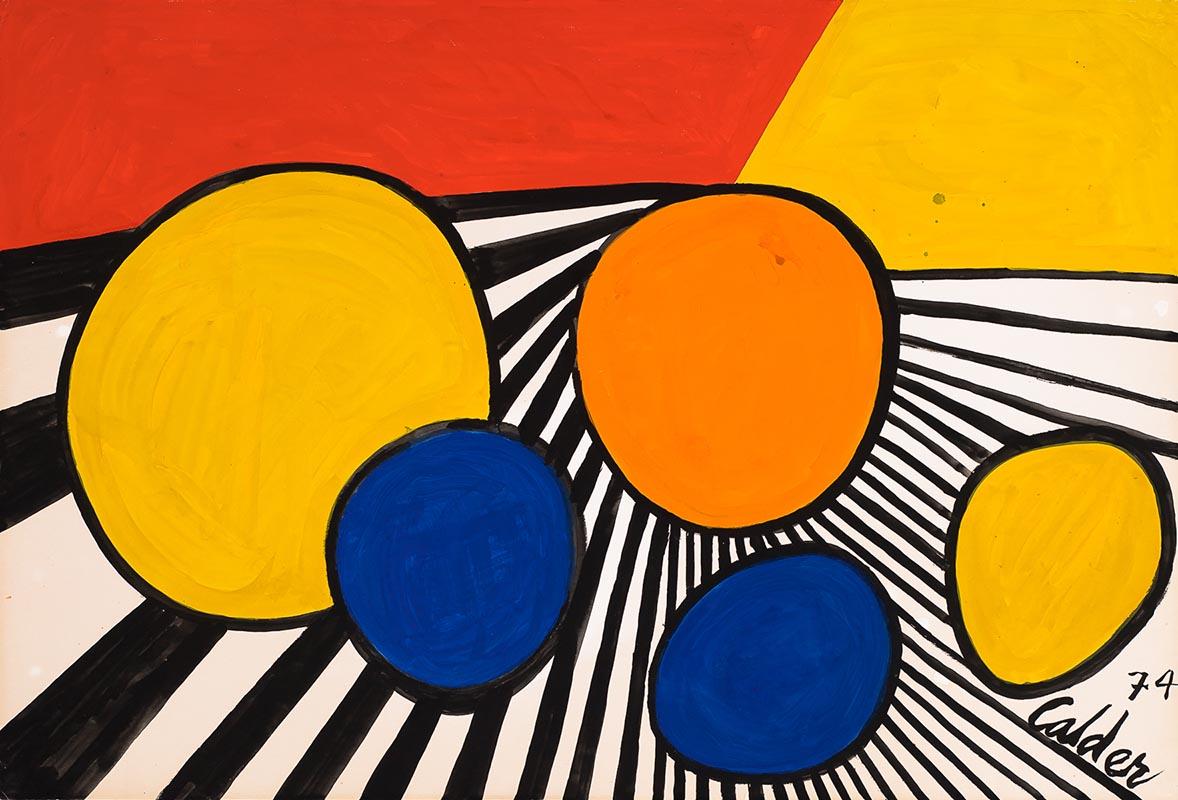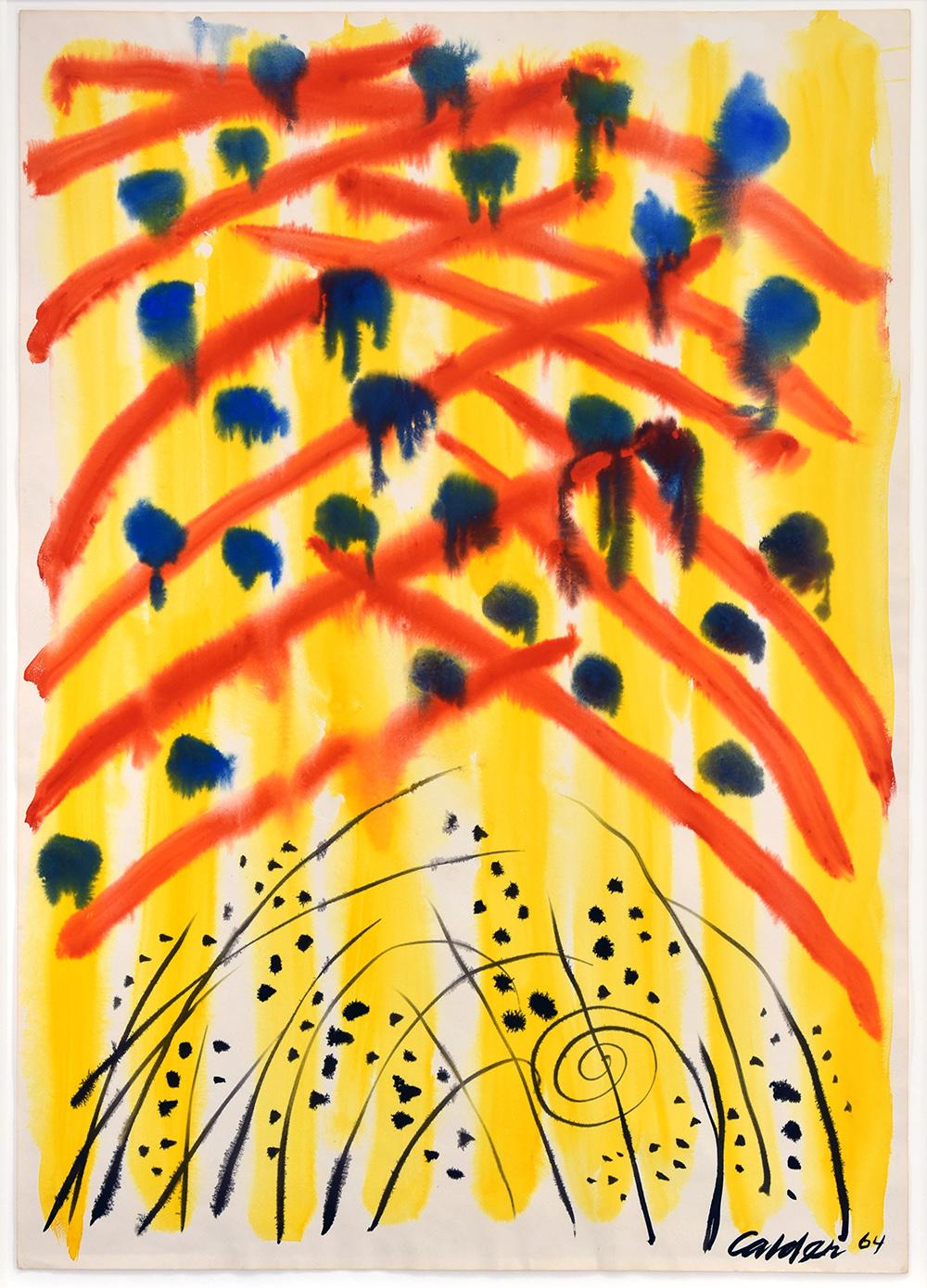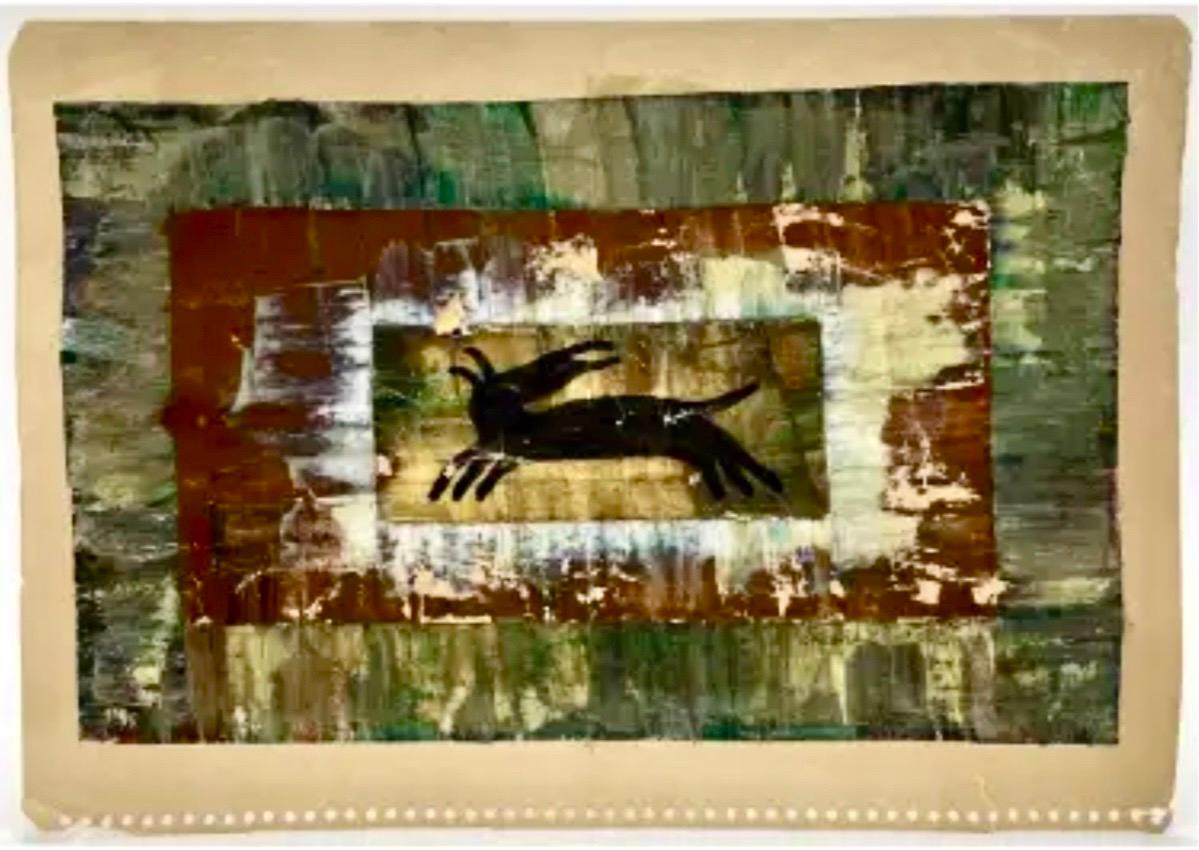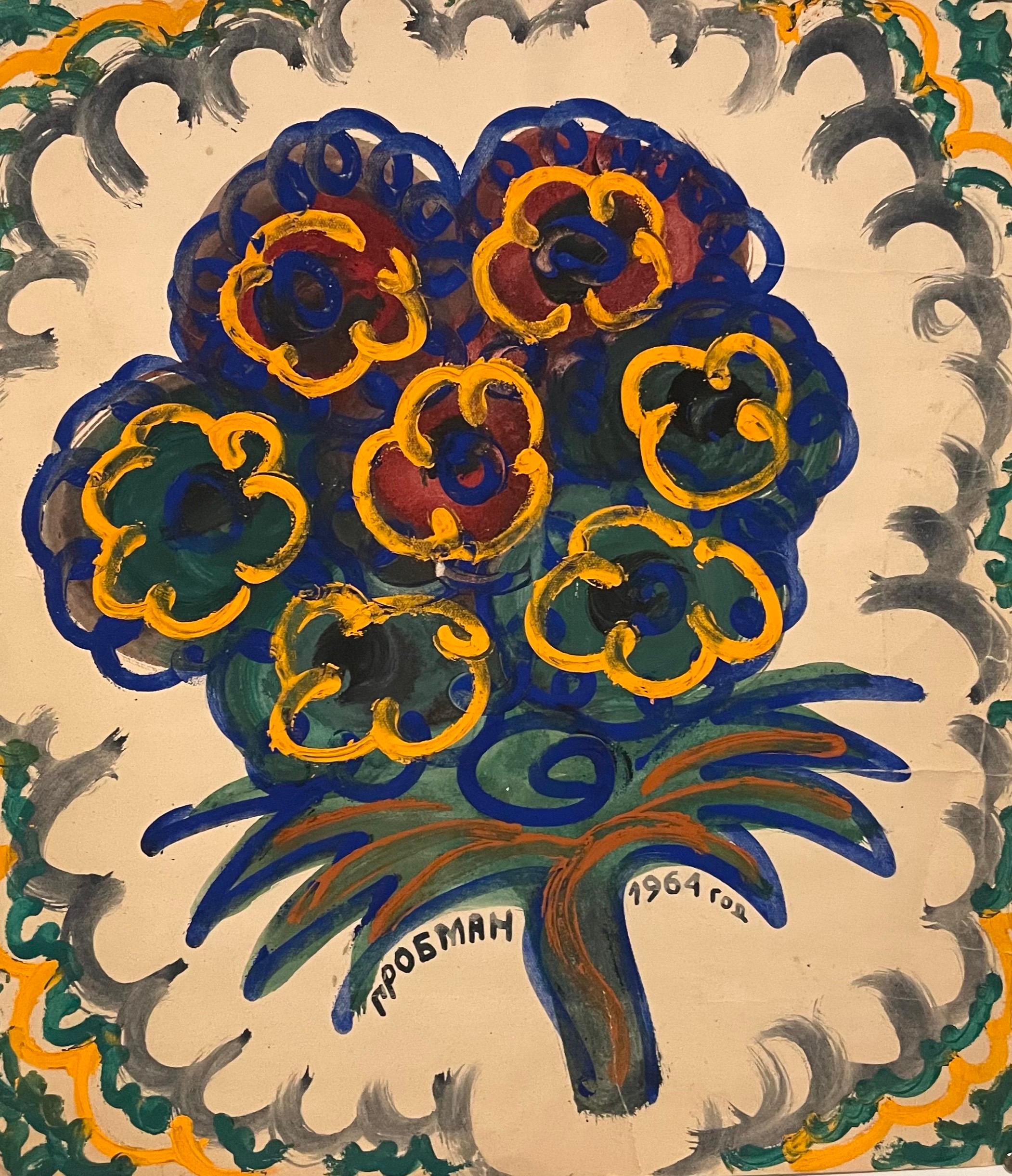Items Similar to Chicago Modernist Gouache Painting Shabbat Hebrew Calligraphy WPA Artist Judaica
Want more images or videos?
Request additional images or videos from the seller
Alexander Raymond KatzChicago Modernist Gouache Painting Shabbat Hebrew Calligraphy WPA Artist Judaica
About the Item
A Judaica painting with Hebrew Calligraphy by noted Chicago Modernist. Alexander Raymond Katz (his Hungarian first name, Sandor, was anglicized to Alexander) was born in Kassa, Hungary, and came to the United States in 1909. He took a job at the Barron Collier company designing car card advertisements, but quit in 1922 to enroll at the School of the Art Institute of Chicago (SAIC) and the Chicago Academy of Fine Arts. In 1927, Katz and his family (he married in 1924) traveled back to Kassa where he pursued his first love, fine art. He reconnected with his Jewish heritage and brought back to Chicago many images of Jewish life. In the late 1920s, he worked as a director of the Poster Department at Paramount Studios. He was appointed the Director of Posters for the Chicago Civic Opera in 1930. During the Great Depression, notable architect Frank Lloyd Wright urged Katz to become a muralist. In 1933, he was commissioned to paint a mural for the Century of Progress exposition in Chicago. In 1936, he painted the mural History of the Immigrant for the Madison, Ill., post office. Katz’s works were included in various exhibitions and now are part of several museum collections, including those of the Art Institute of Chicago; Corcoran Gallery of Art, Washington, D.C.; and the Jewish Museum, New York. Katz was the recipient of numerous commissions for synagogues all over the country, creating stained glass windows, murals, bas reliefs, sculptures, and decorative items for them. He set up a studio in his apartment building and opened an office in the tower of the Auditorium Building that also housed the Little Gallery, an important venue for progressive art in the city, which operated until 1933.
Katz and other Jewish artists in Chicago who expressed Jewish and Biblical themes were inspired by the artist Abel Pann (1883-1963). Pann, who is regarded as the leading painter of the Land of Israel, exhibited in the Art Institute of Chicago in 1920.
Early in his career, Katz began to explore the artistic, aesthetic and philosophical possibilities inherent in the characters of the Hebrew alphabet. He developed aesthetic and philosophical interpretations of each letter and became the leading innovator and pioneer in the field of Hebraic art.
His woodcut Moses and the Burning Bush, was included in the portfolio, A Gift to Birobidjan in 1937. Hebrew letters are integrated into the image.
During the Great Depression, the architect Frank Lloyd Wright urged Katz to become a muralist and in 1933, he was one of eleven artists chosen to create murals for the 1933 Century of Progress Exposition in Chicago He won the competition for best poster for the fair in 1934.
Like many artists in the 1930s, Katz participated in the government-supported arts projects. In 1936, Katz won the commission to paint the mural, History of the Immigrant, for the post office in Madison, Illinois, from the Treasury Department, the most prestigious of the projects. Katz received much acclaim for his murals at the Century of Progress World's Fair and for other WPA projects during the 1930s. His murals are at the Butler Institute of American Art; the Evansville, Indiana Museum' Madison Illinois Post Office and the Oak Park Illinois Jewish Temple.
- Creator:Alexander Raymond Katz (1895-1974, Hungarian)
- Dimensions:Height: 23 in (58.42 cm)Width: 18 in (45.72 cm)
- Medium:
- Movement & Style:
- Period:
- Condition:
- Gallery Location:Surfside, FL
- Reference Number:1stDibs: LU38210576942
About the Seller
4.9
Platinum Seller
These expertly vetted sellers are 1stDibs' most experienced sellers and are rated highest by our customers.
Established in 1995
1stDibs seller since 2014
1,549 sales on 1stDibs
Typical response time: 1 hour
- ShippingRetrieving quote...Ships From: Surfside, FL
- Return PolicyA return for this item may be initiated within 3 days of delivery.
More From This SellerView All
- Post Soviet Avant Garde Russian Israeli Gouache Collage Painting GrobmanBy Michail GrobmanLocated in Surfside, FLMichail Grobman (Russian: Михаил Гробман, Hebrew: מיכאיל גרובמן, born 1939) is an artist and a poet working in Israel and Russia. He is father to Hollywood producer Lati Grobman and Israeli architect Yasha Jacob Grobman. Biography 1939 – Born in Moscow. 1960s – Active member of The Second Russian Avant-Garde movement in the Soviet Union. 1967 – Member of Moscow Artists Union. 1971 – Emigrates to Israel and settles in Jerusalem. 1975 – Founded the Leviathan group and art periodical (in Russian). Since 1983, he lives and works mainly in Tel Aviv. Awards In 2001, Grobman was a co-recipient of the Dizengoff Prize for Painting. Solo exhibitions 2007 – Last Skies, Loushy & Peter Art & Projects, Tel Aviv (cat. text: Marc Scheps) 2006 – Creation From Chaos to Cosmos, Bar-David Museum of Fine Art and Judaica, Kibbutz Baram (cat. text: Sorin Heller) 2002 – The Last Sky, installation, Tsveta Zuzoritch pavilion, Belgrad (cat. text: Irina Subotitch) 1999 – Mikhail Grobman: Works 1960–1998, The State Russian Museum, St. Petersburg (cat. texts: Evgenija Petrova, Marc Scheps, Lola Kantor-Kazovsky, Michail German) Michail Grobman was born in Moscow. He grew up writing poetry, essays and literary prose. In the 1960s, he was active in the Second Russian Avant-garde movement in the Soviet Union. In 1971, he immigrated to Israel. In 1975, he established the Leviathan school together with Avraham Ofek and Shmuel Ackerman, seeking to combine symbolism, metaphysics and Judaism in an all-inclusive “national style.” Grobman’s lithograph work employs images and symbols from Jewish mysticism and Kabbalah. His paintings incorporate texts in Russian and Hebrew. In addition to his artistic endeavors, he writes about art and aesthetics. The group combined conceptual art and "land art" with Jewish symbolism. Of the three of them Avraham Ofek had the deepest interest in sculpture and its relationship to religious symbolism and images. In one series of his works Ofek used mirrors to project Hebrew letters, words with religious or cabbalistic significance, and other images onto soil or man-made structures. In his work "Letters of Light" (1979), for example, the letters were projected onto people and fabrics and the soil of the Judean Desert. In another work Ofek screened the words "America", "Africa", and "Green card" on the walls of the Tel Hai courtyard during a symposium on sculpture Part of the generation of emigre Russian artists, many Jewish, that included Yuri Kuper, Komar and Melamid, Eduard Steinberg, Erik Bulatov, Viktor Pivovarov, Vladimir Yankilevsky, Ilya Kabakov and Grisha Bruskin. Date of Birth: 1939, Moscow 1960s Active member of The Second Russian Avant Garde 1967 Member of the Moscow Painters Association 1971 Immigrated to Israel and settled in Jerusalem 1975 Founded the Leviathan group and art periodical (in Russian) Since 1983 Lives and works in Tel Aviv . Selected Solo Exhibitions: 2002 Pavilion Zveta Zuzovich, "The Last Sky", Belgrad (cat: Irena Subotitch) 1999 The State Russian Museum, ST. Petersburg 1998 "Picture = Symbol + Concept", Herzliya Museum of Art, Herzliya 1995 "Password and Image", University Gallery, Haifa University 1990 Tova Osman Gallery, Tel Aviv 1989 "The Beautiful Sixties in Moscow", The Genia Schreiber University Art Gallery, Tel Aviv University (with llya Kabakov; cat. text: Mordechai Omer] Spertus Museum, Chicago Beit Rami and Uri Nechushtan, Ashdot Yaacov (leaflet) 1972 Nora Gallery, Jerusalem 1973 - Negev Museum, Beer Sheva 1971 Tel Aviv Museum of Art (cat. text: Haim Gamzu) 1966 Mos-lng-Projekt, Moscow 1965 Artist's House, Moscow Energy Institute, Moscow History Institute, Moscow Usti-nad-Orlicy Theatre,Czechoslovakia (leaflet text: Dushan Konetchni) 1959 Mukhina Art Institute, Leningrad . Selected Group Exhibitions: 2003 "Yes do yourself...", Regeneration of Judaism in Israeli art, Zman Omanut Tel Aviv (cat: Gideon Ofrat) 1999 "Russian post-war avantgarde", The Trajsman Collection in the State Russian Museum, St. Petersburg Tretjakov National Gallery, Moscow (cat. text: Yevgenij Barabanov, John...Category
1960s Modern Mixed Media
MaterialsPaper, Watercolor, Gouache
- Post Soviet Nonconformist Avant Garde Russian Israeli Gouache Painting GrobmanBy Michail GrobmanLocated in Surfside, FLMIchail Grobman Gouache and watercolor on paper Hand signed Lower Left and Dated 1964. Described inn Cyrillic Russian verso. Dimensions: L:13.25" W: 11.75". Michail Grobman (Russian: Михаил Гробман, Hebrew: מיכאיל גרובמן, born 1939) is an artist and a poet working in Israel and Russia. He is father to Hollywood producer Lati Grobman and Israeli architect Yasha Jacob Grobman. Biography 1939 – Born in Moscow. 1960s – Active member of The Second Russian Avant-Garde movement in the Soviet Union. 1967 – Member of Moscow Artists Union. 1971 – Emigrates to Israel and settles in Jerusalem. 1975 – Founded the Leviathan group and art periodical (in Russian). Since 1983, he lives and works mainly in Tel Aviv. Awards In 2001, Grobman was a co-recipient of the Dizengoff Prize for Painting. Solo exhibitions 2007 – Last Skies, Loushy & Peter Art & Projects, Tel Aviv (cat. text: Marc Scheps) 2006 – Creation From Chaos to Cosmos, Bar-David Museum of Fine Art and Judaica, Kibbutz Baram (cat. text: Sorin Heller) 2002 – The Last Sky, installation, Tsveta Zuzoritch pavilion, Belgrad (cat. text: Irina Subotitch) 1999 – Mikhail Grobman: Works 1960–1998, The State Russian Museum, St. Petersburg (cat. texts: Evgeniya Petrova, Marc Scheps, Lola Kantor-Kazovsky, Michail German) Michail Grobman was born in Moscow. He grew up writing poetry, essays and literary prose. In the 1960s, he was active in the Second Russian Avant-garde movement in the Soviet Union. In 1971, he immigrated to Israel. In 1975, he established the Leviathan school together with Avraham Ofek and Shmuel Ackerman, seeking to combine symbolism, metaphysics and Judaism in an all-inclusive “national style.” Grobman’s lithograph work employs images and symbols from Jewish mysticism and Kabbalah. His paintings incorporate texts in Russian and Hebrew. In addition to his artistic endeavors, he writes about art and aesthetics. The group combined conceptual art and "land art" with Jewish symbolism. Of the three of them Avraham Ofek had the deepest interest in sculpture and its relationship to religious symbolism and images. In one series of his works Ofek used mirrors to project Hebrew letters, words with religious or cabbalistic significance, and other images onto soil or man-made structures. In his work "Letters of Light" (1979), for example, the letters were projected onto people and fabrics and the soil of the Judean Desert. In another work Ofek screened the words "America", "Africa", and "Green card" on the walls of the Tel Hai courtyard during a symposium on sculpture Part of the generation of emigre Russian artists, many Jewish, that included Yuri Kuper, Komar and Melamid, Eduard Steinberg, Erik Bulatov, Viktor Pivovarov, Vladimir Yankilevsky, Ilya Kabakov and Grisha Bruskin. Date of Birth: 1939, Moscow 1960s Active member of The Second Russian Avant Garde 1967 Member of the Moscow Painters Association 1971 Immigrated to Israel and settled in Jerusalem 1975 Founded the Leviathan group and art periodical (in Russian) Since 1983 Lives and works in Tel Aviv . Selected Solo Exhibitions: 2002 Pavilion Zveta Zuzovich, "The Last Sky", Belgrad (cat: Irena Subotitch) 1999 The State Russian Museum, ST. Petersburg 1998 "Picture = Symbol + Concept", Herzliya Museum of Art, Herzliya 1995 "Password and Image", University Gallery, Haifa University 1990 Tova Osman Gallery, Tel Aviv 1989 "The Beautiful Sixties in Moscow", The Genia Schreiber University Art Gallery, Tel Aviv University (with llya Kabakov; cat. text: Mordechai Omer] Spertus Museum, Chicago Beit Rami and Uri Nechushtan, Ashdot Yaacov (leaflet) 1972 Nora Gallery, Jerusalem 1973 - Negev Museum, Beer Sheva 1971 Tel Aviv Museum of Art (cat. text: Haim Gamzu) 1966 Mos-lng-Projekt, Moscow 1965 Artist's House, Moscow Energy Institute, Moscow History Institute, Moscow Usti-nad-Orlicy Theatre,Czechoslovakia (leaflet text: Dushan Konetchni) 1959 Mukhina Art Institute, Leningrad . Selected Group Exhibitions: 2003 "Yes do yourself...", Regeneration of Judaism in Israeli art, Zman Omanut Tel Aviv (cat: Gideon Ofrat) 1999 "Russian post-war avantgarde", The Trajsman Collection in the State Russian Museum, St. Petersburg Tretjakov National Gallery, Moscow (cat. text: Yevgenij Barabanov, John Bolt...Category
1960s Modern Abstract Paintings
MaterialsPaper, Watercolor, Gouache
- Abstract Landscape with Palm Tree Judaica Gouache PaintingBy Mane KatzLocated in Surfside, FLMane-Katz (1894-1962) Landscape with palm tree. Gouache on paper, signed lower right. Dimensions: (Frame) H 37.5" x W 31", (Sight) H 24.5" x W 18" Emmanuel Mané-Katz (Hebrew:מאנה כ...Category
20th Century Modern Abstract Paintings
MaterialsGouache
- Early Abstract Expressionist Gouache Painting WPA Jewish ArtistBy Louis WolchonokLocated in Surfside, FLLouis Wolchonok was a social realist painter and member of the Woodstock Art Association. His work was exhibited at the Whitney Museum of American Art, the National Academy of Design...Category
20th Century Modern Abstract Paintings
MaterialsPaper, Gouache
- Early Abstract Expressionist Oil Painting Monoprint WPA Jewish ArtistBy Louis WolchonokLocated in Surfside, FLLouis Wolchonok was a social realist painter and member of the Woodstock Art Association. His work was exhibited at the Whitney Museum of American Art, the National Academy of Design...Category
20th Century Modern Abstract Paintings
MaterialsPaper, Gouache
- Romanian Modernist Gouache Painting Of Buildings And Boats - Jean DavidBy Jean DavidLocated in Surfside, FLJean David was a painter and designer, known for his contributions to the Romanian avant-garde and to the early modernist art of Israel (then recently founded). He was the first Israeli artist to be inducted into the illustrious Alliance Graphique Nationale in 1954. He had studied between 1927 and 1937 at various art academies in Paris. In 1929 he participated for the first time at a collective exhibition in Bucharest and in 1933 he had his first personal exhibition (in the same city). In the early '30s he was a member of the Surrealist group "unu" (meaning "one"). In 1942, he left Romania in a boat with 12 other Jews, including Theodor Brauner, the brother of Victor Brauner. After being captured by British authorities in Cyprus, he managed to reach Palestine in 1944. In 1949 he went to live in Jerusalem, where he was active in developing ceramic arts, sculpture works in copper, and artistic tapestry wall hangings under the auspices of the Ministry of Trade and Industry. Together with Marcel Janco, he founded in Israel the artist village known as Ein Hod. He also gained much reputation as a muralist and graphic and poster designer, having designed numerous posters and other works for the El Al air company, Maccabiah games, Zim shipping and The Israel tourist industry. David’s primary importance was in the design of posters. He used a wildly colorful decorative style in his art, which combined illustration, caricature, and national figures. In addition he designed wall hangings for “Maskit,” and also worked in the decoration of public buildings. His paintings had elements of Surrealism and included images from nature and landscapes. Similar in style to David Klein and the Polish Cyrk posters. Forms From Israel, Mounting Exhibition, USA, 1958 Artists: El Hanani (Sapozhnikow), Arie Azaz, Nehemiah Boris Carmi, Hanna Harag Zunz, David, Jean David Gumbel, Keiner Forcheimer, Julia Mansfeld, Al Merom, Peter Mayer, Jean Palombo...Category
Mid-20th Century Modern Figurative Paintings
MaterialsGouache, Paper
You May Also Like
- Bowling, 1974By Alexander CalderLocated in Greenwich, CTBowling gouache and ink on paper 29.5 x 43.25" signed and dated "Calder 74" on recto, lower right This work is registered in the archives of the Calder Foundation, New York. LITERA...Category
20th Century Modern Paintings
MaterialsPaper, Gouache
- Untitled, 1964By Alexander CalderLocated in Palo Alto, CARenowned for his mobiles, Alexander Calder applies the same principles of movement found in his sculptural works in this gouache work titled Untitled, 1964. Vertical yellow stripes cover the background, over which crisscrossed lines of red are punctuated with dripping blue dots. The layers of color bleed into each other, drawing attention to the water-based medium of the pigments. Gouache paint consists of opaque pigments ground in water and a thickener, which yields an especially rich color for a water-based paint. Thin abstracted lines and dots in black fill the lower half of the composition with the same swaying movement of grass blades in the wind. The swirl in the lower right corner of the composition is a signature formal motif in both Calder’s three-dimensional and two-dimensional works. Through a masterful handling of gouache, Alexander Calder Untitled...Category
1960s Modern Abstract Paintings
MaterialsInk, Gouache
- Untitled [Abstraction]By George L.K. MorrisLocated in New York, NYGouache on paper, 18 7/8 x 14 3/4 in. Signed (at lower right): Morris; (with monogram, on the back): GLKM [monogram] / 1932 [sic] Executed circa late 1940s A passionate advocate of abstract art during the 1930s and 1940s, George L. K. Morris was active as a painter, sculptor, editor, and critic. An erudite man with an internationalist point of view, Morris eschewed the social, political, and figural concerns that preoccupied so many artists of Depression-era America, believing that painters should focus their attention on the beauty, refinement, and simplicity of pure form instead. His goal, he said, was “to wedge the expression further and further into the confines of the canvas until every shape takes on a spatial meaning” (as quoted in Ward Jackson, “George L. K. Morris: Forty Years of Abstract Art,” Art Journal 32 [Winter 1972–73], p. 150). Born into an affluent family in New York City, Morris was a descendent of General Lewis Morris, a signer of the Declaration of Independence. From 1918 until 1924, he attended the Groton School in Connecticut, studying classics and art. He continued to focus on literature and art while attending Yale University (1924–28), an experience that prepared him well for his future activity as an artist-critic. After graduating in 1928, Morris studied at the Art Students League of New York, working under the realist painters John Sloan and Kenneth Hayes Miller, as well as Jan Matulka, the only modernist on the faculty. In the spring of 1929, Morris traveled to Paris with Albert E. Gallatin, a family friend and fellow painter who introduced him to leading members of the Parisian avant-garde, including Jean Arp, Pablo Picasso, Georges Braque, Jean Hélion, and Piet Mondrian. Morris also took classes at the Académie Moderne, studying under Fernand Léger and Amédée Ozenfant, important exponents of Synthetic Cubism who influenced his aesthetic development. Indeed, after experimenting with the simplified forms of Modernism for a few years, Morris moved on to abstraction by 1934, adopting a hard-edged, geometric approach inspired by Leger’s cubist style and the biomorphic shapes of Arp and Joan Miró. Following his return to New York in 1930, Morris built a white-walled, open-spaced studio (inspired by that of Ozenfant, which had been designed by Le Corbusier) on the grounds of Brockhurst, his parents’ 46-acre estate in Lenox, Massachusetts. In 1935, he married the painter and collagist Estelle “Suzy...Category
1940s American Modern Abstract Paintings
MaterialsPaper, Gouache
- Composition - Painting By Reynold Arnould - 1970Located in Roma, ITComposition is a Gouache realized by Reynold Arnould (Le Havre 1919 - Parigi 1980). Good condition. No signature. Reynold Arnould was born in Le Havre, France in 1919. He studied...Category
1970s Modern Abstract Paintings
MaterialsPaper, Gouache
- Led Zeppelin - Houses Of The Holy (Grammy, Album Art, Iconic, Rock and Roll)By Kerry SmithLocated in Kansas City, MOKerry Smith Led Zeppelin - Houses Of The Holy Mixed Media on Crescent board Year: 2018 Size: 21x20in Signed, dated by hand COA provided Ref.: 924802-1632 --------------------------...Category
2010s American Modern Figurative Paintings
MaterialsMixed Media, Acrylic, Gouache, Board
- 'Fish, Dove and Musical Instrument', Italian School (circa 1940s)Located in London, GB'Fish, Dove and Musical Instrument', gouache on paper, from the Italian School of artists (circa 1940s). Surely this very attractive piece was inspired by Georges Braque (1882-1963) ...Category
1940s Modern Abstract Paintings
MaterialsPaper, Gouache
Recently Viewed
View AllMore Ways To Browse
Chicago Artists
Chicago Painting
Paintings Of Chicago
Painting By Chicago
Art Institute Of Chicago
Chicago Modern
Chicago Fine Art
Chicago Abstract
Chicago City
Chicago School
Chicago Modern Painting
Century Of Progress
Illinois Artists
Illinois Artist
Chicago Fair
Gouache Paint Used For
Calligraphic Paintings
Calligraphy Painting


![Untitled [Abstraction]](https://a.1stdibscdn.com/george-lk-morris-1905-1975-american-paintings-untitled-abstraction-for-sale/a_23/1652214284908/APG_8941_unfr_master.jpg)


